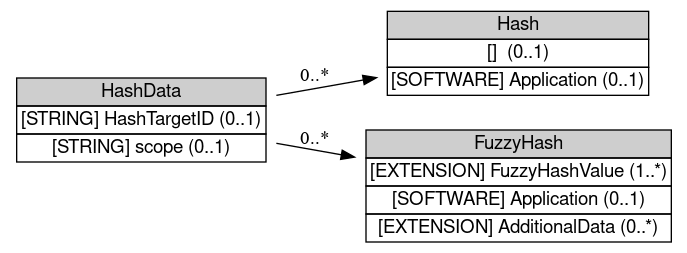HashData
The HashData class describes different types of hashes on a given object (e.g., file, part of a file, email).

digraph HashData { graph [bb="0,0,507,181.5", rankdir=LR ]; node [label="\N"]; HashData [height=0.98611, label=<<table BORDER="0" CELLBORDER="1" CELLSPACING="0"> <tr> <td BGCOLOR="#CECECE" HREF="/idmef_parser/IODEFv2/HashData.html" TITLE="The HashData class describes different types of hashes on a given object (e.g., file, part of a file, email). "><FONT FACE="Nimbus Sans L">HashData</FONT></td> </tr>" %<tr><td HREF="/idmef_parser/IODEFv2/HashData.html" TITLE="An identifier that references a subset of the object being hashed. The semantics of this identifier are specified by the scope attribute."><FONT FACE="Nimbus Sans L">[STRING] HashTargetID (0..1)</FONT></td></tr>%<tr><td HREF="/idmef_parser/IODEFv2/HashData.html" TITLE="A means by which to extend the scope attribute. See Section 5.1.1."><FONT FACE="Nimbus Sans L">[STRING] scope (0..1)</FONT></td></tr>%</table>>, pos="101.5,96", shape=plaintext, width=2.8194]; Hash [height=0.98611, label=<<table BORDER="0" CELLBORDER="1" CELLSPACING="0"> <tr> <td BGCOLOR="#CECECE" HREF="/idmef_parser/IODEFv2/Hash.html" TITLE="The Hash class describes a cryptographic hash value; the algorithm and application used to generate it; and the canonicalization method applied to the object being hashed. "><FONT FACE="Nimbus Sans L">Hash</FONT></td> </tr>" %<tr><td HREF="/idmef_parser/IODEFv2/Hash.html" TITLE="The canonicalization method used on the object being hashed. See Section 4.3.1 of [W3C.XMLSIG]."><FONT FACE="Nimbus Sans L">[] (0..1)</FONT></td></tr>%<tr><td HREF="/idmef_parser/IODEFv2/Hash.html" TITLE="The application used to calculate the hash."><FONT FACE="Nimbus Sans L">[SOFTWARE] Application (0..1)</FONT></td></tr>%</table>>, pos="384.5,146", shape=plaintext, width=2.9444]; HashData -> Hash [label="0..*", lp="232.5,128.5", pos="e,278.39,127.25 203.27,113.98 224.43,117.72 246.88,121.69 268.51,125.51"]; FuzzyHash [height=1.2778, label=<<table BORDER="0" CELLBORDER="1" CELLSPACING="0"> <tr> <td BGCOLOR="#CECECE" HREF="/idmef_parser/IODEFv2/FuzzyHash.html" TITLE="The FuzzyHash class describes a fuzzy hash and the application used to generate it. "><FONT FACE="Nimbus Sans L">FuzzyHash</FONT></td> </tr>" %<tr><td HREF="/idmef_parser/IODEFv2/FuzzyHash.html" TITLE="The computed fuzzy hash value."><FONT FACE="Nimbus Sans L">[EXTENSION] FuzzyHashValue (1..*)</FONT></td></tr>%<tr><td HREF="/idmef_parser/IODEFv2/FuzzyHash.html" TITLE="The application used to calculate the hash."><FONT FACE="Nimbus Sans L">[SOFTWARE] Application (0..1)</FONT></td></tr>%<tr><td HREF="/idmef_parser/IODEFv2/FuzzyHash.html" TITLE="Mechanism by which to extend the data model."><FONT FACE="Nimbus Sans L">[EXTENSION] AdditionalData (0..*)</FONT></td></tr>%</table>>, pos="384.5,46", shape=plaintext, width=3.4028]; HashData -> FuzzyHash [label="0..*", lp="232.5,81.5", pos="e,261.91,67.659 203.27,78.019 219.02,75.237 235.48,72.329 251.78,69.448"]; }
Aggregates
HashTargetID (0..1)
An identifier that references a subset of the object being hashed. The semantics of this identifier are specified by the scope attribute.
Hash (0..*)
The hash of an object. See Section 3.26.1.
FuzzyHash (0..*)
The fuzzy hash of an object. See Section 3.26.2.
scope (0..1)
A means by which to extend the scope attribute. See Section 5.1.1.